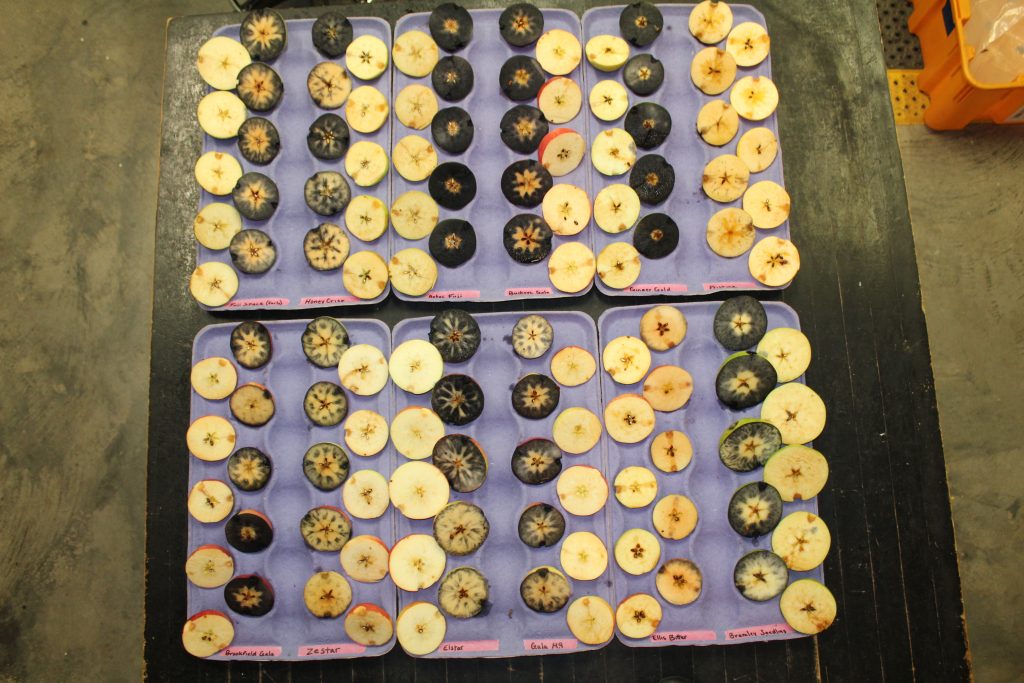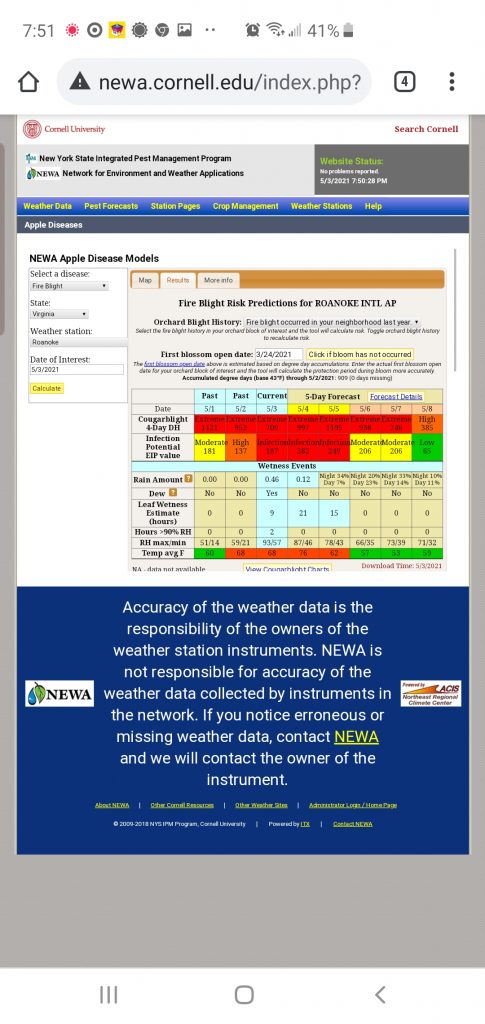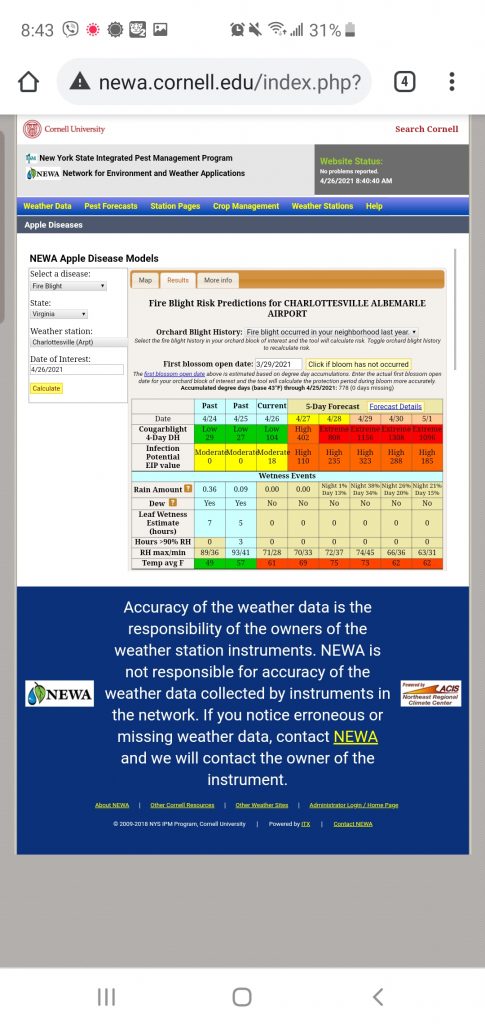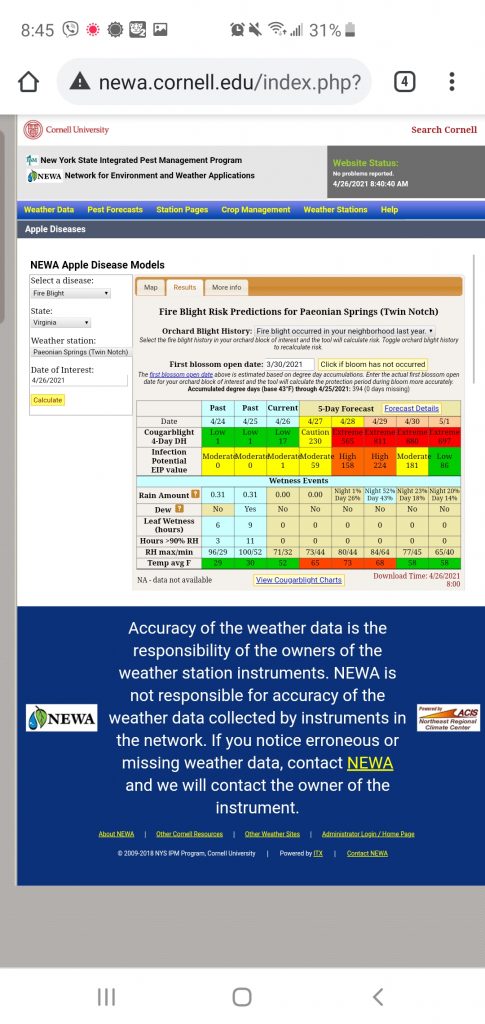

, 2021.
To get information about the starch index, iodine solution recipes, and different maturity indices please refer to our blog post at https://blogs.ext.vt.edu/tree-fruit-horticulture/2012/08/23/harvest-maturity-resources/







Below is the apple maturity report for the Winchester/Fredrick county area (Table 1). We measured fruit firmness (lb), fruit color, total soluble solids (Brix), and starch conversion rate (1-8 index) for 12 apple cultivars grown in the AHS Jr. AREC’s and we will keep sending similar reports throughout the harvest season to help you determine the optimal harvest time for your apple varieties. More varieties will be added to the table below as we move through the harvest season. We have assessed fruit firmness, Brix, and starch index according to the methods we described previously in another blog post (https://blogs.ext.vt.edu/tree-fruit-horticulture/2012/08/23/harvest-maturity-resources/). We used a DA meter to measure fruit coloration. The DA device measures the chlorophyll content in the fruit, just below the skin. As the fruit ripens, chlorophyll degrades, and DA readings decline accordingly. Starch index, fruit firmness and, ‘to some degree’, Brix values, are used either alone or in combination to determine the harvest date for most commercial apple varieties. In Table 2, you will find the estimated firmness and starch index values at which apples should be harvested for controlled atmosphere (CA) storage and fresh consumption. If you don’t see your variety in the list, you can generally harvest your crop at starch index (3-5), firmness (> 16 lb), and DA reading (0.60) for CA storage. But if the crop is intended for fresh market, then wait until starch index of (5.5-7), firmness (13-16 lb), DA reading (0.35) and Brix (12-14%). Again, there are varietal differences, so it’s always recommended to use more than one maturity index to determine the optimal harvest time.




The pre-harvest drop refers to the abscission of fruits from the tree before horticultural maturity. Depending on the cultivar and growing season, yield losses due to pre-harvest drop can reach 30%. Factors such as heat and drought stress, heavy insect infestation, and late summer pruning can increase the severity of fruit drop. Early-maturing cultivars (e.g., Gala and Honeycrisp) are usually more prone to fruit drop than late-maturing cultivars (e.g., Fuji and Pink Lady). Ethylene, the ripening hormone, is considered the primary driver of pre-harvest drop, and therefore ethylene inhibitors are used to control the pre-harvest drop in apple orchards. ReTain (from Valent Bioscience) and Harvista (from AgroFresh) are the two ethylene inhibitors labeled for pre-harvest drop control in Virginia. ReTain inhibits the biosynthesis/production of ethylene, whereas Harvista prevents ethylene reception and action. The purpose of this blog post is to share with you the results of two experimental trials we conducted in the 2018 and 2019 seasons to explore the effects of different rates and application timings on the efficacy of these materials.
In 2018: we examined two rates of ReTain (166g/acre and 333g/acre) and three application timings (1 week, 3 weeks and (1 & 3) weeks before the anticipated harvest date) on the percentage of fruit drop (%) of Gala apples. We used 6 trees per treatment. We flagged and counted 100 fruit/tree at 4 weeks before harvest (WBH), and we counted the fruits on these trees every week starting at 1 WBH through 4 WAH. The percentage of fruit drop (%) at each stage was calculated relative to the initial fruit count. In addition to fruit drop, we also investigated the effects of different treatments on fruit quality parameters (fruit weight, size, firmness, color, sugar content, starch index, and acidity). The findings of this trial can be concluded in four points: a) The effect of ReTain treatments on fruit drop was more evident at 1 and 2 weeks after harvest. b) Applying ReTain at the full rate (333g/acre) 3 weeks before the anticipated harvest date reduced fruit drop by 40-50% and extended the harvest season by 1-2 weeks. The same results were obtained when ReTain was used at half rate (166g/acre) at 1 and 3 WBH. C) fruits treated with ReTain (full rate) were firmer, had a lower starch index and lower brix than the untreated checks. However, ReTain-treated fruits were generally less colored than untreated checks. D) no differences in fruit size were found between ReTain- treated and untreated fruits. (Please refer to Tables 1 & 2).
Table 1: The effects of ReTain rate and application timing on the pre-harvest fruit drop (%) of Gala apples-Season 2018.

Table 2: Gala fruit quality as affected by ReTain applications- 2018.

In 2019: we examined 2 rates of ReTain (333 g/acre and 666 g/acre), 1 rate of Harvista (121 fl oz/acre), 3 application timings for ReTain (at 1, 3 and (1&3) weeks before harvest) and 2 application timings for Harvista (at starch index 2 and at starch index (1.5 and 3). Again, six trees were used per treatment. The total number of fruits on each tree was counted four weeks before harvest. The percentage of fruit drop was calculated starting at 1 WBH and through 3 WAH. We also examined the effects of different treatments on the fruit quality of Gala apples at harvest. Our results indicated that: a) a full rate (333 g/acre) of ReTain applied at 3 WBH was not statistically different than a double rate (666 g/acre); b) Harvista applied twice (at starch index 1.5 and 3) showed better results on fruit drop than the single application (at starch index 2); c) There were no significant effects on fruit size and weight when either ReTain or Harvista were used; d) Fruits treated with ReTain were generally firmer than control, but had poor coloration; e) Harvista did not improve fruit coloration, but also did not reduce it compared to control; f) ReTain applications at a full rate significantly reduced the fruit’s ethylene content, but it required two applications of Harvista to acquire the same effect. (Please refer to Tables 3 & 4)
Table 3: ReTain and Harvista effects on the pre-harvest fruit drop (%) of Gala apples-2019

Table 4: ReTain and Harvista effects on fruit quality of ‘Gala’ apples-2019

Other general notes:

Our fruit size averages for ‘Gala’, ‘Red Delicious’ and ‘Honeycrisp apples in Winchester are 15.66, 14.9 and 13.23 mm, respectively. If you applied thinning treatments on May 2 or 4, you should be able to see thinning responses by now. Fruitlets to be abscised will be loose and easily pulled off. In order to assess the response of thinning applications applied on May 4, we marked the fruitlets of 10 clusters of Gala, Honeycrisp and Reds and tracked their sizes in the last three days using a digital caliper. The idea behind this was to monitor the fruit growth rate and determine how many fruitlets will eventually abscise. Fruitlets to be abscised are believed to have a growth rate that is less than 50% of the fastest growing fruit on the tree. For instance, the fastest growth rate for Gala in the past three days was 0.6 mm per day. A fruit in the cluster that shows less than 0.3 mm/day will likely abscise soon. Based on this, we have found that our thinning applications on May 4, will result on 50%, 67%, 82% abscission rate for Reds, Gala and Honeycrisp, respectively. On other words, we should expect more triples, doubles and singles/cluster for these three cultivars, respectively. Our per acre thinning rates for Gala and Reds were (64-96 fl oz of Exilis + 1 qt of Sevin + 1 pt of Regulaid). For Honeycrisp, our rate was (4.5 oz of Refine + 1 qt of Sevin + 1 pt of Regulaid). If you applied similar rates on the same day for the same cultivars, your responses will be likely the same.

If, after assessing thinning responses in your orchard, you still feel that another thinning application is required, it’s still possible to apply 6-BA and NAA applications until your average fruit sizes are ~ 18 mm. NAA would likely result in better thinning responses at this stage. As shown in the figure below, the carbohydrate model predicts carbohydrate surplus in the next three days and therefore the recommendations are to increase the rate of thinning materials by 30%.
For cultivars exceeding an average fruit size of 20 mm , NAA and 6-BA applications won’t be effective. If more thinning is required, the only chemical option available would be ethephon. You will find more information about rescue thinning by ethephon in the following blog post (https://blogs.ext.vt.edu/tree-fruit-horticulture/2020/05/20/apple-rescue-thinning-by-ethephon/).

A message from Dr. Srdjan Acimovic:
In any apple trees blocks still at bloom (young planted trees, and any orchards with rat tail bloom): fire blight infections have occurred on 5/3 in or around Charlottesville, Lynchburg, Wakefield and on 5/2 and 5/3 in Red Hill, and in Red Hill and Wakefield the infection will occur again tomorrow 5/4 and 5/5. Please examine attached NEWA EIP print screens. Protect by applying 1.5 lbs/A Harbour or Agri-Mycin plus Regulaid 1 pt/100 gal, before rain/dew triggering infection or up to 24 h after that rain, on any apple tees in bloom. You can still apply 5/3 for infection that occurred on 5/2. If you did not protect against the infection/s on 5/2 apply Apogee at 12 oz/100 Gal as soon as you can, best 1-3 days after infection event that you did not apply streptomycin for. Use of Apogee for and unprotected infections beyond the 24 h after infection has occurred will help you prevent fire blight cankers to develop from the currently incubating infections.








Greetings,
Looking at the carbohydrate thinning model and weather forecast for this week (May 2- May 9), you can realize that we, at Winchester/Fredrick county area, have only a couple of days that could be suitable for our primary fruit thinning applications. As shown in the carbohydrate model below, we are approaching the recommended degree days of 200-250 DD by this Wednesday (May 5), which would be perfect for applying our regular thinning treatments if it’s not raining that day. However, it will be apparently cold and/or rainy for the rest of the week, leaving us with only two days with temperatures above 80 oF (Sunday, May 2 and Tuesday, May 4), which is good for the activity of our main thinning materials, 6-BA and NAA. These thinners don’t work well when temperatures are below 70F. Therefore, I would recommend targeting these two days (May 2 and 4) for thinning applications. Although our current DD is slightly under the recommended range, our fruit sizes lie within the perfect range (7-13 mm) for thinning applications. In our last zoom meeting this past Wednesday, we discussed the materials and rates you can use for thinning Gala, Fuji, Honeycrisp and several other cultivars. You can access this information by following this link: https://blogs.ext.vt.edu/tree-fruit-horticulture/2021/04/20/apple-fruit-thinning-scenarios-2021/
As you can see in the model page below, the last column refers to the recommended application rate based on the 7-day carbon balance. The model suggests a standard rate of thinning material for Sunday applications and 30% increase in thinning rates for Tuesday. In other words, if your standard rate for MaxCel is (64 fl oz + 2 pt of carbaryl/acre); you need to add (83 fl oz of MaxCel + 2.6 pt of carbaryl/acre) on Tuesday. This 30% increase doesn’t apply to the surfactants you apply with the thinning mix. Please also note that some forms of 6-BA (such as Exilis 9.5) have 5X active ingredient and therefore the amounts used in the example above will be different. Similarly, for NAA there are two forms of Refine (Refine 3.5 and Refine 6.25) that contain different concentrations of ai. Please read the product label before applying any of these chemicals. Finally, feel free to approach me via the email and telephone number mentioned below.



Dear All: Please find below a message from Dr. Srdjan Acimovic.
In any apple trees blocks still at bloom, fire blight infection will be possible if weather forecast from NWS changes from what is now used to run EIP NEWA fire blight model: i.e. if dew or rain occurs. The currently orange labeled EIP cells with values above 100 could turn to Red color and word Infection if dew or rain occurs (attached), keep looking at model every day. Some locations (airports) I attached show that red cell change to Infection due to wetting. If this change occurs, apply 1.5 lbs/A Harbour or Agri-Mycin plus Regulaid 1 pt/100 gal, before rain/dew triggering infection or up to 24 h after that rain, on any apple or pear trees in bloom.











Greetings:
Please see below the updates from Dr. Srdjan Acimovic on the fire blight situation in Virginia.
If the data from Roanoke International Airport station are correct there will be fire blight infection today 4/14 triggered by the rain, in and near Roanoke. Growers should apply strep 1.5 lb + Regulaid 1 pt/100 before rain or apply this mix up to 24 h after the rain event that triggered the infection. What puzzles me is that Floyd (CLH), not so far away from Roanoke, has no infection predicted for 4/14, leading me to believe that it either one of the two stations is not calibrated properly OR it will be hit or miss in terms of where rain/dew lands. Next, the infection occurred in Esmont (Rees), Lynchburg, and Red Hill yesterday 3/13 and if the growers did not apply streptomycin before the rain/dew on 3/13 triggering the infection, they must and can still apply strep 1.5 lb + Regulaid 1 pt/100 today i.e, up to 24 h after the rain event that triggered the infection for it to be effective. In Lynchburg infection is also predicted today 4/14 and the spray today 4/14 will cover for both infections 4/13 and 4/14. In Richmond, if the station is plugging in the correct weather data into the model, there was contiguous infection 4/9-12 which is not good, and proper response as per my previous blog was to spray on 4/10, and 4/12 to cover for all 4 infections and both times growers should have applied strep 1.5 lb + Regulaid 1 pt/100 to get 24 h kick-back and thus cover for all 4 infections. This is based on my experiences from eastern NY and is different from the VA spray guidelines that currently state that a streptomycin application remains effective 3-5 days. Based on this experience with the outbreaks I saw after similar block of infection in NY, I disagree with that 3-5 days as per my blog published here: 1. Frightful Blight Model Cases How Long A Streptomycin Spray Lasts; 2. Major Scab Infection/s Possible 25-30 or 28-29 May All East NY posted on May 25, 2020. In Rustburg (Crown), I would apply strep 1.5 lb + Regulaid 1 pt/100 tomorrow 4/15 if the “High” risk turns into “Infection” for 4/14 in NEWA’s EIP model. Danville has had infections continuously from 4/8-12, assuming correct weather data. Most other weather stations do not indicate a risk from infection, assuming they are functioning properly in collecting the weather data. Please check your closest weather station in NEWA daily, and apply protection according to the EIP model, and make sure it is functioning properly before you can trust the model outputs from it.
You can reach Dr. Acimovic at 517-449-0905
